KEY TAKEAWAYS:
PA speakers are for live performances. They are designed to be very loud but do lack audio quality because of this. Studio monitors are designed to have a flat frequency response, producing the most realistic sound of the audio. This is for detailed audio work, such as production and mixing.
Different Speaker Types

There are so many different kinds of speakers, and it can be challenging to choose which one suits your needs.
If you’re a musician, the main two types of speakers that you hear about are PA speakers and studio monitors.
But what is so different about these different speakers? Can they be used for the same thing?
This article will explore what a PA speaker and studio monitor are, their differences, and how to use them.
What Are PA Speakers?
PA speakers are typically part of a PA system. PA is short for public address, as these systems are designed to be listened to by an audience. Therefore, a PA speaker’s primary purpose is to produce sound at a loud enough level to be heard by the entire audience.
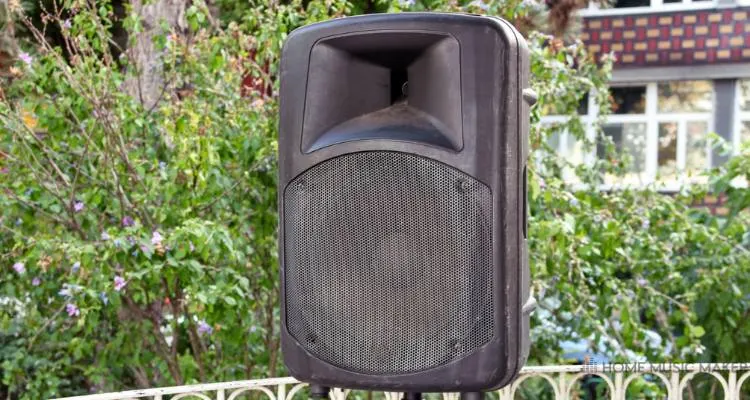
You’d expect to see other equipment with PA speakers: a mixer, a monitor, multiple monitor speakers (a.k.a. a stage monitor), and a sound source.
Since this is a music-based article, we focus on the music being played or performed. But of course, there are other uses for a PA system and a PA speaker, such as a stand-up comedy show.
There are two main types of PA speakers to be considered. There are passive speakers and active speakers.
For passive speakers, a power amplifier is needed to power the speakers.
Active speakers, i.e., powered speakers, have their built-in amplifier.
You don’t plug in passive speakers, but you do plug in active speakers.
What Are Studio Monitors?
A studio monitor is a speaker crafted for use within professional sound production, whether for music, television, podcasts, etc.
The idea behind a studio monitor speaker is that they have a very flat frequency response to produce the most honest audio possible.
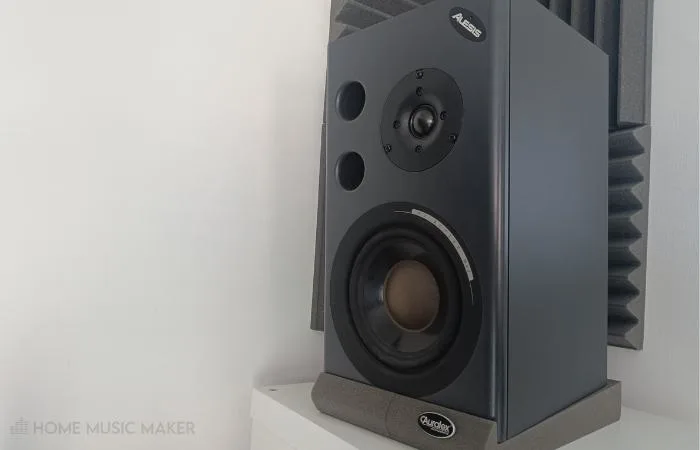
Specific speakers emphasize or reduce groups of frequencies in their frequency response to provide a more pleasing experience for the listener. When working in professional sound production, the frequency response of regular speakers will give a biased interpretation of the sound.
However, in this scenario, we want the actual sound of the audio.
Having a flat frequency response means that the person working with the speakers can adjust their audio based on how the audio sounds and not based on the speaker’s bias. As with a PA speaker, there is also the choice of using an active studio monitor (powered studio monitor) or a passive studio monitor.
These are active and passive by the exact definition as the PA speaker is described.
READ NEXT:
Maybe you’re questioning whether you need anything else to get your studio monitors to play music. In this case, check out our article on whether you need an audio interface for studio monitors.
Most home studio monitor speakers are between 5″ and 8″ in size. In a professional studio, you’re likelier to see 8″ studio monitors or larger and sometimes a subwoofer. The larger the speaker size, the larger the bass response.
Adding a subwoofer to the setup allows for an even larger bass response than that.
Most companies produce different ranges of monitors aimed at different budgets and scenarios.
The big companies for this are Adam Audio, Yamaha, KRK, Genelec, Mackie, and Focal.
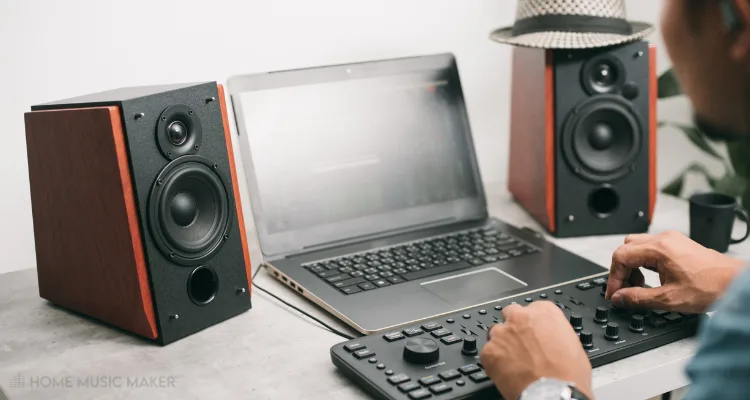
READ NEXT:
Are you looking for a new pair of studio monitors? Check out our KRK Rokit 5 G4 review.
What Are The Differences Between PA Speakers And Studio Monitors?
The main difference between the two speakers is their purpose, which dictates how they are designed and built. Of course, no one speaker can do everything, so there will be sacrifices for different speaker types to prioritize other aspects of the audio.
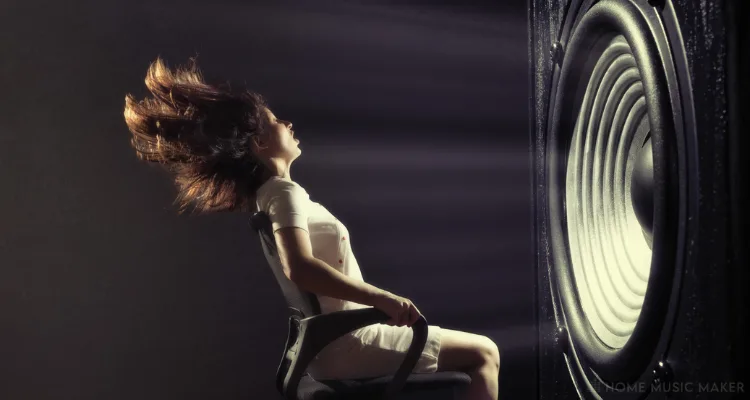
A PA speaker is designed to be loud. Loud!
Think about when you go to a festival or a large gig. Thousands must hear the sound, sometimes tens of thousands of people. The big thing that gets sacrificed with this is audio quality.
You’re not going to get a perfect frequency response with a PA speaker. Far from it. But you will hear it, coupled with the live energy; it still sounds fantastic.
A studio monitor is designed to project sound as authentically as possible, with no bias, even at low volumes. They are intended to be used in a studio where there are few people and you’re doing detailed work on the sound.
Here, volume isn’t a priority, so the studio speakers are less loud than PA speakers. But the frequency response is as flat as possible for the most realistic reproduction of the sound.
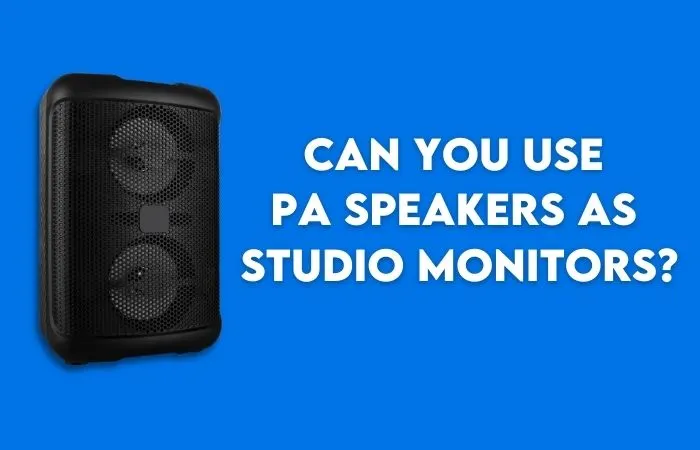
Can You Use PA Speakers As Studio Monitors?
To get to the point, no. PA speakers are not designed to produce the clearest-sounding audio. They are designed to be as loud as possible. Doing any audio work through a PA speaker will result in having to do it again, as it will not sound good on other speakers.
Also, PA speakers are massive. Much bigger than studio monitors. So it doesn’t make sense to have them in a studio, let alone your home studio.
You can use PA speakers for referencing in a studio setting. If you’re a performer using backing tracks and want an idea of how it will sound through a PA speaker, then referencing could help. However, look at it more as a rough idea than a clear interpretation. The venue being performed will also massively contribute to the sound being heard.
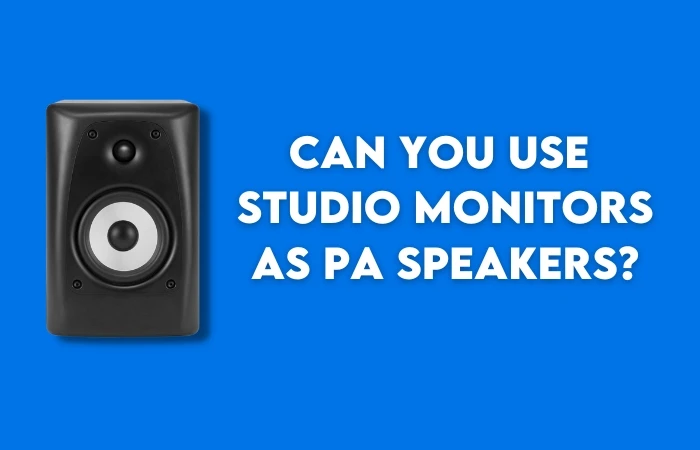
Can You Use Studio Monitors As PA Speakers?
The biggest issue with using studio monitors as PA speakers is the volume. A studio monitor can get pretty loud, maybe even loud enough for a small gig. However, they are designed to do something other than this, and you will quickly deteriorate your studio monitor by doing this.
Studio monitors are near-field monitors. This means that they are designed to be listened to up close. They even have a sweet spot where the audio produced by the two speakers crosses into your ears in the best way.
Can You Produce And Mix With PA Speakers?
Not really, no. You could somewhat write and produce music with PA speakers if you’re looking at hearing what you’re recording or generally arranging a song. Still, even then, I wouldn’t recommend it.
A PA speaker will give you such an unrealistic idea of the sound of your music. It will sound completely different when playing it on other speakers. It’s just different from what they’re designed for. They are designed for live sound.
Related Questions
How To Choose PA Speakers Vs. Studio Monitors?
This all depends on the intended use for getting a speaker.
Do you want to play a live performance for a group of people or even a large audience? Then you will need PA speakers.
Instead, do you want speakers to use for music production? Great, then you should get studio monitors.
PA Speakers That Double As Studio Monitors?
There isn’t any product out there that does this. The purposes of both speakers mean that they need to improve in what the other excels at. Studio monitors have a flat frequency response. Due to the design, this cannot be played at loud volumes for PA speakers.
PA speakers need to be very loud. However, in being able to produce a loud sound, their frequency response is not flat. Therefore they are unsuited to be used as studio monitors.
Opinion On PA Speakers Vs. Studio Monitors For Home Use?
I can only think of a single reason you would need a PA speaker in your home if it were for practicing a live performance or putting on a live performance.
Studio monitors are only helpful for the home when some form of home studio and music production work is done there.
However, if you’re looking for a great set of speakers for listening to music leisurely, consider going for hi-fi speakers or a high-quality Bluetooth speaker. These are designed to allow you to enjoy music at home.
Do You Need A Mixer For PA Speakers?
You can plug your audio source straight into active PA speakers and play. Some active speakers have a form of EQ to help shape the sound, but it’s still limited. So for active speakers, no, you don’t need a mixer. However, using one will give you more control in shaping the sound from the speakers.
You will need a mixer and a power amplifier for passive PA speakers. Some mixers come with a power amplifier built in, some don’t, and you have to buy one separately.
Why Do Producers Use Studio Monitors?
It’s typical for a producer to use a combination of studio monitors and headphones. Studio monitors allow a producer to hear tiny details within the mix that a regular speaker wouldn’t pick up.
READ NEXT:
Still trying to figure out if you need studio monitors? Check our article on whether studio monitors are necessary.

 Want to connect with other music producers for help and guidance?
Want to connect with other music producers for help and guidance?